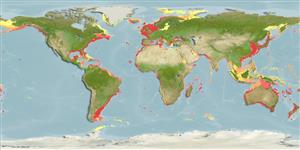Common names from other countries
Environment: milieu / climate zone / depth range / distribution range
Écologie
Pélagique; saumâtre; profondeur 0 - 200 m (Ref. 1134). Tropical; 3°C - 30°C (Ref. 1134)
Distribution
Pays | Zones FAO | Écosystèmes | Occurrences | Introductions
Circumglobal except Antarctic.
Length at first maturity / Taille / Poids / Âge
Maturity: Lm ? range ? - ? cm Max length : 0.2 cm TL mâle / non sexé; (Ref. 1610)
Marine, planktonic; found at depths up to 200 m, with waters temperatures of 3.2 to 29.5°C; rare in the open sea (Ref. 1134). Prefers neritic ambience (Ref. 3531). Found in mangrove vegetate area (Ref. 121475).
Life cycle and mating behavior
Maturité | Reproduction | Frai | Œufs | Fécondité | Larves
Members of the class Appendicularia are protandrous hermaphrodites. Life cycle: Eggs develop into hatchlings (feeding juveniles) before turning into adults.
Hopcroft, R.R., J.C. Roff and H.A. Bouman. 1998. (Ref. 378)
Statut dans la liste rouge de l'IUCN (Ref. 130435)
statut CITES (Ref. 108899)
Not Evaluated
Not Evaluated
Utilisations par l'homme
| FishSource |
Outils
Plus d'informations
Taille/ÂgeCroissanceLongueur-poidsLongueur-longueurMorphologieLarvesAbondance
Sources Internet
Estimates based on models
Preferred temperature
(Ref.
115969): 6.5 - 25.9, mean 13.6 (based on 2008 cells).
Vulnérabilité
Low vulnerability (10 of 100).
Catégorie de prix
Unknown.
